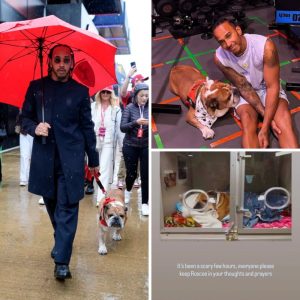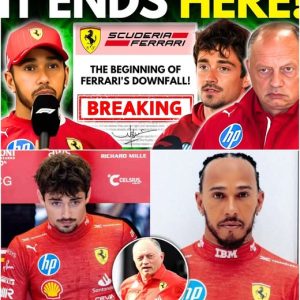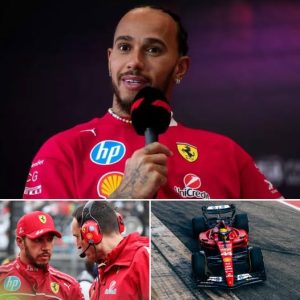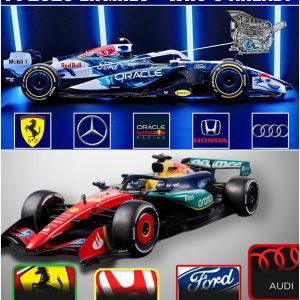The world of Formula 1, an arena of speed, glamour, and fierce rivalries, often delivers heart-stopping and dramatic moments to its audience. However, behind this dazzling facade lie stories of resilience, love, and personal pain that deeply touch the hearts of fans.
This past week, two such stories simultaneously sent shockwaves through the community, exposing the profound human aspects of F1 drivers: Romain Grosjean’s emotional return after a horrific accident, and Lewis Hamilton’s painful decision to withdraw from a crucial test for his four-legged friend who was on the brink of death.
Romain Grosjean: A Return From The Jaws Of Death, An Emotional Conclusion
Let’s rewind to the 2020 Bahrain Grand Prix, a fateful day etched into the memory of every F1 enthusiast. It was a moment where life and death were separated by a mere fraction of a second. Romain Grosjean’s Haas car, after a terrifying collision, pierced a guardrail, burst into a violent inferno, and split in two.
The image of a massive fireball engulfing the car left the world holding its breath, fearing the absolute worst. For 27 long seconds, Grosjean was trapped within the blaze, enduring an impact measured at an incredible 67G—a force almost beyond imagination.
And yet, a miracle occurred. Romain Grosjean, in a truly incredible feat of survival, emerged from the flaming wreckage. His injuries, thankfully, were limited to burns on the back of his hands—an unbelievable outcome given the severity of the crash.
The incident was not only a grim reminder of the inherent dangers of Formula 1 but also a testament to the remarkable safety of modern F1 cars and the astounding survival instincts of a human being. Grosjean was forced to miss the final two races of the 2020 season and was unable to secure a seat for 2021, making it seem as though his F1 career had ended in the most traumatic and abrupt way possible.
But Grosjean is a fighter. He had long cherished a wish: to have one final “farewell run” in an F1 car, an opportunity to say goodbye to the sport properly, with no regrets. And finally, that dream became a reality. At the Mugello Circuit, Romain Grosjean had the chance to get back behind the wheel of a Haas F1 car, specifically the 2023 Challenger, during a session under F1’s “testing of previous cars” regulations. He was reunited with his old team and could once again feel the sense of speed that he knew so well.
Although the test day was wet, Grosjean was filled with emotion and gratitude. “It was a wet day, but as we say with a wedding, rainy wedding, happy wedding,” he shared. “So it was a rainy day, happy day, fantastic.” He admitted to being a “bit rusty” at first, but then “everything came back.” The most poignant moment for him was performing a standing start, which brought back memories of his last start in Bahrain 2020. “This time it turns out way better,” he said. “A very unique opportunity, getting to see some of the people that were in Australia 2016 and get to drive the new generation of car. It was fantastic and I’m very grateful.”
This run was more than just a test drive; it was a form of spiritual healing, a meaningful redemption for an F1 career that deserved a more fitting conclusion. It was an affirmation of an indomitable spirit, overcoming fear and trauma to return to the place that had nearly claimed his life. Grosjean’s comeback brought hope and inspiration to many, proving that even after the most horrific events, one can rise again and pursue their passion.
Lewis Hamilton: The Sacrifice of Unconditional Love
While Romain Grosjean was savoring his moment of personal triumph at Mugello, another story, one of sorrow and profound love, was tugging at the heartstrings of the F1 community. Lewis Hamilton, the great F1 champion, unexpectedly withdrew from a critical Pirelli tire test at the same circuit. This test was vital for the development of Pirelli’s tires for the 2026 season, with teams like Haas and Ferrari participating to gather invaluable data. In Hamilton’s place, driver Zhou Guanyu was dispatched by Ferrari to join Charles Leclerc.
The reason behind Hamilton’s sudden decision was not an injury or a technical issue related to the track, but something far deeper and more personal: he wanted to be by the side of his best friend, his dog Roscoe, who had fallen into a critical coma. Hamilton shared Roscoe’s alarming condition on Instagram, an emotional plea to his fans and friends. “Please keep Rosco in your thoughts,” he wrote. “I want to keep you all updated. Rosco has pneumonia again and was struggling to breathe.”
Hamilton’s post continued with a detailed and heart-wrenching account of Roscoe’s condition: “He was admitted into hospital and sedated to calm him while they did checks on him. During the process, his heart stopped. They managed to get a heartbeat back and now he’s in a coma. We don’t know whether he’ll wake up from this tomorrow. I’m by his side and want to thank you all for your prayers and support.”
These words revealed a vulnerable and deeply human side of one of the world’s greatest athletes. The bond between Lewis Hamilton and Roscoe is more than just that of an owner and a pet. Roscoe has been an integral part of Hamilton’s life since 2013. The English Bulldog has become a familiar sight in the F1 paddock over the years, often appearing alongside Hamilton at races, most recently at the British Grand Prix at Silverstone in July. Roscoe is not just a dog; he is a loyal companion, a family member, and a boundless source of comfort and joy for Hamilton.
The decision to withdraw from a crucial test—a rare move for a driver as disciplined and dedicated as Hamilton—spoke volumes about the depth of his affection for Roscoe. In a world where every millisecond counts and every test session can influence the outcome of future seasons, Hamilton’s choice to put Roscoe first sent a powerful message about the importance of love and personal bonds. “This must be such a difficult time for Hamilton, and I hope Rosco gets through this and is okay,” the video’s narrator shared, echoing the sentiments of the entire F1 community.
![]()
Contrasting Stories, A Shared Humanity
The two stories of Romain Grosjean and Lewis Hamilton, though different in context and emotion, together paint a profound picture of the human nature of F1’s heroes. Grosjean, with his resilient return from a terrifying accident, demonstrated an incredible will to live and a desire to find peace in his career. He turned fear into motivation, a traumatic past into a moment of healing and joy. His story is a tribute to the unyielding human spirit, showing that one can overcome even near-death experiences to find peace and passion again.
Meanwhile, Lewis Hamilton, by forgoing his professional duties to be with his best friend in his hour of need, displayed a deep love and a clear prioritization of family. In a sport often perceived as cold and competitive, Hamilton’s actions remind us that even global icons have fears and powerful emotional connections to the small creatures in their lives. It highlights the human side of these drivers, showing they are individuals with hearts, emotions, and a willingness to sacrifice for what they love.
Both of these stories have transcended the confines of the racetrack, touching upon universal values of resilience, compassion, and the importance of love. They are a reminder that, even at the pinnacle of a grueling sport, F1 drivers are human beings with their own emotional personal stories, challenges, and victories that occur not just on the track, but in their own lives. The F1 community and fans worldwide have shared in these moments, forging a stronger connection between drivers and their audience, and deepening the human meaning of this high-speed sport.





